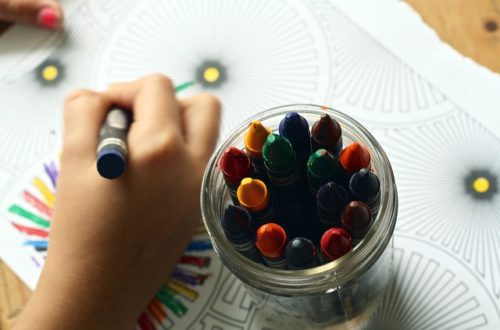Sending your small child off to daycare, preschool, or school is difficult. It can be challenging to maintain a connection with what your child is doing, who their friends are, and how they are progressing in the program, especially if you are also working outside the home and might have limited opportunities to interact beyond drop-off and pick-up.
When my son was in preschool I was pretty spoiled in this department, with a very strong connection to the preschool even though I work nearly full time outside of the home. In addition to twice-a-year conferences and quick conversations at drop-off and pick-up, I got a daily emailed report of all his activities and the things they had learned that day. His teachers even would tell me what he had eaten for lunch, and how he had liked each food. We were invited along on field trips and outings, and I attended as much as I could. In this way I got to know and became friends with many of the parents of the other children in his class.
When he started kindergarten I knew that I wouldn’t get this level of communication. There are just too many kids and the teachers have too much to do to engage in that level of personal connection with each parent. But I still wanted to have a connection to the school, the teachers, and the 18 kids that he spent so many waking hours of the day with. Luckily, I work a slightly non-traditional schedule and have one day off during the week. After a background check and the appropriate volunteer application, I was able to spend time in his class about once a month during the school year, as well as accompany the class on one field trip during the year.

The time I spent with my son’s class was both eye-opening and wonderful. I got to put faces to his friend’s names, see the classroom where he was learning, and connect with his teacher. I also learned some very important things about kindergarten, kindergarten teachers, and our public school system in general. There are really too many things to list, but here are 4 things I learned this year in the time I spent in my son’s kindergarten classroom:
1. Kindergarten teachers (and aides) are saints.
No really, they are. In the time that I spent in my son’s classroom I saw his teacher working hard at imparting knowledge to young minds while simultaneously being a coach, referee, lawyer, advocate, nurse, cheerleader, disciplinarian, and IT professional. She wiped noses and helped clean up unfortunately bathroom incidents. And this is just for the kids. On top of this, she sent weekly emails regarding the learning happening in the classroom to the parents, organized field trips, created stimulating lesson plans, and took care to know each of her students as individual people. We don’t pay teachers enough, especially kindergarten teachers. The least we can do is acknowledge the important role they play in our kids’ lives.
2. Recess and free play are essential to learning.
As a pediatric physical therapist, I already knew the value of physical activity. Kids learn with their bodies, and they need time to run, jump, play, and explore in order to be able to take full advantage of education. Our modern education system places a lot of pressure on kids to sit still, pay attention, and perform at levels that are often out of pace with what is actually developmentally appropriate for five- and six-year old kids, and those 15-20 minutes of free time to run outside can be vital to centering their little nervous systems to be able to continue their school day.
One week when I was in the classroom, it had been raining for three straight days. Since our elementary school needs the gym for pretty much every class period of the day, recess had been quiet play in the classroom for THREE STRAIGHT DAYS. The kids were seriously squirley, impatient, and were having a very tough time getting through their math lesson. It was all their teacher could do to get them through to lunch, praying that the weather would clear for the afternoon. (Please refer to #1 point above).
3. That “Common Core Math?” Not so crazy.
One of the first times I volunteered, the class was completing a math lesson that seemed to come straight out of one of those internet memes about “Common Core Math.” (You know, the ones that like to make fun of taking something that should be simple and making it complicated.) In previous days, the kids had been talking about the number line, and ordering of numbers from 1-9. Today, the teacher wrote the numbers 6 and 8 on the board and asked one of the girls to come up and circle which number was bigger. She did so quickly, and the teacher asked her, “But how do you KNOW that 8 is bigger than 6?”
I have to take a second and abashedly admit here that I inwardly rolled my eyes for just a second. What do you mean how do you know 8 is bigger than 6? It just is! It’s a fact that need not be disputed or supported. It just is.
But the little girl looked quite confidently at her teacher and said, “Well, I thought in my brain, and I thought of the number line, and 8 came after 6 so I knew that it was larger, because the numbers on the number line that come last are the biggest.” The teacher praised her thinking and went on with the lesson.
Wow. As I listened to the exchange I realized that this six-year-old had used logic and known facts to support a statement. Where I might have just said, “It just is!” and left it at that, she was able to use what she had learned to make a proof of sorts as to why she was correct. In this case, it was a simple math concept. But what happens when she is solving more complex problems and is able to apply an understanding of concepts to novel situations, instead of just relying on rote memory? How much further might that take her?
Now don’t get me wrong. I am by no means an expert on “Standards Based Education” (aka Common Core) and have no ability to debate the pros and cons of the system. But I did see in this teaching moment a side of the system I hadn’t considered.
4. Small things can make all the difference.
I’m lucky enough to have a flexible work schedule that allowed me to come into my son’s classroom for an hour, once a month or so. I was also able to chaperone a field trip and contribute with the PTO on a few occasions. I have never felt more valued, or more appreciated, than the time that I have been able to spend in the classroom. Every single time that I was there I was thanked by more than one person for the simple things I was doing: hanging up artwork, organizing papers, helping with math homework. In reality, it was ME that should have been thanking all of those education professional that were working so hard to make my son’s year a successful one.
Once when I was volunteering, I noticed that several of the students’ pencils were worn down and needed to be sharpened, so I asked his teacher where the pencil sharpener was. She let me know that hers had broken, and she hadn’t had time to go buy a new one, so I could go next door and use the one there.
Wait….SHE hadn’t had time to go buy a new one? I had heard people talk about teachers needing to spend their own money on basic classroom supplies, but this was the first time the reality of lack of funding for basic school needs had hit me right in the face. I realized then that while I couldn’t volunteer as much as I’d like to, one thing I COULD do was head to Amazon Prime and make sure that a new electric pencil sharpener was in the classroom within 48 hours. (Thank you free two-day shipping!) Once again, this very simple thing was met with thanks and gratitude, and made a positive effect on both the teacher’s daily life and the students’ ability to learn.
Parents, our public school teachers have an extremely hard job.
They are tasked with molding young minds with varying needs and backgrounds, with a list of rules and regulations a mile long, and all on a shoestring budget. We can help make their job easier in so many small ways. Everyone’s situation is different, and you might be able to volunteer in the classroom, help in the office, send in a few extra snacks, buy a few extra pencils at the beginning of the year or shoot your kid’s teacher an email asking what they are running short of in the classroom.
Even if you can’t do any of these things, you can support the learning that is happening in your child’s classroom by listening to your child, asking about the things he or she is learning in school, and being engaged with their lessons. The time that I spent in my son’s kindergarten classroom this year drove that point home to me, and reminded me that we can positively influence the lives of kids with even the smallest amount of efforts.
To all of our readers who are teachers, paraprofessionals, custodians, lunch room attendants, principals, and other education professionals…thank you for the work you do every day.
We at ICMB appreciate and salute you!










